Tuesday, July 06, 2004
A FAQ
I have been asked this quite a lot: “which language do you think in, Polish or English?” Possibly I have had this query levied at times when it has been painfully obvious that I was not born into an English speaking environment (so that, after listening to me, or reading something I put together in my awkward foreign-person way, a person is tempted to ask “so…do you ever at least THINK in English?”)
When I was a kid I would give this serious consideration. I would go into my head and attempt to pay attention to my thinking process. I wanted to catch myself: “ha! Wasn’t that Polish? No, I distinctly pick out an English phrase there…”
But over time, I came to believe that it can’t be done. If you think about thinking (can one do that?) you come to realize that you are always envisioning yourself in conversation with some entity. The minute someone asks which language I think in, I rivet to the language of the inquirer.
And what of the times when no one is asking? How do I, how do multi-language people in general think? It is still the case that thinking about it forces a language, typically of the environment one is in. I dare anyone to take a moment now and contemplate with some detachment how thoughts spin inside one’s head. Mind-boggling, isn’t it?
There is only one worse question out there and I get this one as well: what language do I dream in? Typically, when asked this, I just make up an answer. I’ve learned that this is far more satisfying than my convoluted diatribe on how it is impossible to recreate thinking about dreaming in the abstract.
When I was a kid I would give this serious consideration. I would go into my head and attempt to pay attention to my thinking process. I wanted to catch myself: “ha! Wasn’t that Polish? No, I distinctly pick out an English phrase there…”
But over time, I came to believe that it can’t be done. If you think about thinking (can one do that?) you come to realize that you are always envisioning yourself in conversation with some entity. The minute someone asks which language I think in, I rivet to the language of the inquirer.
And what of the times when no one is asking? How do I, how do multi-language people in general think? It is still the case that thinking about it forces a language, typically of the environment one is in. I dare anyone to take a moment now and contemplate with some detachment how thoughts spin inside one’s head. Mind-boggling, isn’t it?
There is only one worse question out there and I get this one as well: what language do I dream in? Typically, when asked this, I just make up an answer. I’ve learned that this is far more satisfying than my convoluted diatribe on how it is impossible to recreate thinking about dreaming in the abstract.
A missing V.I.P.P.
Next week, between Monday and Wednesday, I have what amounts to a nine-hour series of lectures to give on a topic that is not within my typical lecture orbit. But neither is it an impossible task, since it is on a topic that is not especially difficult for a law prof of any field to speak on. All I need is time. I am a rather meticulous lecturer. I never go into a class without comprehensive lecture notes. I don’t read them while presenting, but anything and everything that I ever say is in some way contained in the sheaf of papers that I bring with me to class. For the hours of teaching that I have before me next week I calculated that I would need 45 pages of single-spaced lecture notes.
Today is Tuesday. I told myself that I absolutely had to begin putting together my 45 page security blanket. But early in the day, I was arrested by a disconserting realization: it struck me that yesterday I left a piece of paper on the kitchen counter. It was a very important piece of paper, folded into an envelope-like enclosure with perforations on all sides. Why do I believe it to be significant? Because it came in the mail this week-end and it had “very important” written all over it. Not literally, but in the presentation. It looked so important that I pulled it out of the stack of mail and placed it on the counter as Something I Must Not Neglect.
Tonight I was attending to paperwork and I could not find this V.I.P.P (very important piece of paper). I looked through the week’s garbage three times, piece by piece, rotten piece of food by rotten piece of food. Nothing. I went through every room in the house, every stack of papers, every drawer of irrelevant trash. Nothing.
I could not stop myself. When I didn’t find it in the first round, I did a more thorough second round. Then a third. Fourth. I’m pausing before my fifth to blog, but a fifth is around the corner.
It could have been vital to my existence. Or, maybe I was wrong. Maybe it just looked important. Maybe it was an invitation to apply for yet another credit card.
As a result of this paper chase I made no inroads on the 45 page single-spaced packet of notes. I can’t decide which is more disconcerting: the fact of the missing slip of paper, or the time lost searching for it.
Daily life
Normally if I ask someone in an email “how’s it going” they respond that they are exceedingly busy and overworked and behind on their projects, etc etc. But one friend writes the following:
“we moved cows from one pasture to the next… I am going to plant june berries underneath the aspen trees…we lost our vegetables to frost last night…” and so on.
How is it that people develop these skills? Do you read books on herding cows and then just do it? What are june berries anyway? And what place in continental US has frost in June? Does it hurt the june berries?
It struck me how during the majority of my days I move within a five mile radius of my home, my actions are limited to the same ones, day in and day out and they do not include moving cattle from one pasture to another. Just as I start to feel competently self-sufficient, I am reminded that I’ve given up on growing my own vegetables because I know the local farmers do it better and I pick up few new skills from season to season.
Thank goodness we have travel to take us out of the ordinary. Daily life can leave you with a rigid tunnel vision and atrophied observational skills, to say nothing of stagnant coping abilities.
“we moved cows from one pasture to the next… I am going to plant june berries underneath the aspen trees…we lost our vegetables to frost last night…” and so on.
How is it that people develop these skills? Do you read books on herding cows and then just do it? What are june berries anyway? And what place in continental US has frost in June? Does it hurt the june berries?
It struck me how during the majority of my days I move within a five mile radius of my home, my actions are limited to the same ones, day in and day out and they do not include moving cattle from one pasture to another. Just as I start to feel competently self-sufficient, I am reminded that I’ve given up on growing my own vegetables because I know the local farmers do it better and I pick up few new skills from season to season.
Thank goodness we have travel to take us out of the ordinary. Daily life can leave you with a rigid tunnel vision and atrophied observational skills, to say nothing of stagnant coping abilities.
Monday, July 05, 2004
Czy chcesz pizze?
Tonight’s dinner was pizza. With all the trepidations surrounding the painting job (see post below), I didn’t have the mind nor the muscle to think about food preparation. So I went to a local pizza place to pick up my order (I am the only one in town, in the country probably, who has never in her entire American life (they don’t do pizza delivery in Poland) ordered a pizza delivery; one quick drive will get me a pie fresh from the oven, so why would I opt for a delivery?).
I wore my “Prawa kobiet prawami czlowieka” t-shirt tonight. Most people pick the next clean t-shirt in the stack to throw on. I choose mine deliberately. I wear the Polish one whenever I miss my connections to that country. [the translation of the words is “women’s rights are people’s rights.” The shirt comes from a friend who works at the Center for Women’s Rights in Warsaw and if you knew how incongruous it is to talk of women’s rights in the Polish context, you’d appreciate how much this t-shirt means to me. It is fading considerably from overuse.]
As I claimed my pizza, the young man said to me “ty rozmawiasz po Polsku?” He had a slight American accent, but he was otherwise quite fluent (translation: you speak Polish, don’t you?).
It turns out that he is a Wisconsin guy who had decided, while in college at UW-Stevens Point, to learn Polish. Eventually, he spent his junior year in Poland. Okay, so he is now dishing out pizza – not a great ad for choosing Polish as you major. But I’m sure he’ll move on to bigger and better things any day now.
I have, until this day, in my many years in this country, met only two people who had had no connection to Poland but had decided to learn the language nonetheless. Both were sociologists who chose to do research in Poland. This young man today will make it a pack of three who will have deliberately studied Polish.
I asked how it could be that he spoke Polish so well. The language is exceedingly hard for Americans, in part because of the conjugation principles (you conjugate nouns as well as verbs, so that if you say “I sit on top of the table” or “I sit under the table,” the word “table” will take on a different form; this additional grammatical idiosyncrasy drives English speaking people completely nuts). He answered simply “jestem bardzo inteligentny” (=I am very intelligent). Indeed!
I wore my “Prawa kobiet prawami czlowieka” t-shirt tonight. Most people pick the next clean t-shirt in the stack to throw on. I choose mine deliberately. I wear the Polish one whenever I miss my connections to that country. [the translation of the words is “women’s rights are people’s rights.” The shirt comes from a friend who works at the Center for Women’s Rights in Warsaw and if you knew how incongruous it is to talk of women’s rights in the Polish context, you’d appreciate how much this t-shirt means to me. It is fading considerably from overuse.]
As I claimed my pizza, the young man said to me “ty rozmawiasz po Polsku?” He had a slight American accent, but he was otherwise quite fluent (translation: you speak Polish, don’t you?).
It turns out that he is a Wisconsin guy who had decided, while in college at UW-Stevens Point, to learn Polish. Eventually, he spent his junior year in Poland. Okay, so he is now dishing out pizza – not a great ad for choosing Polish as you major. But I’m sure he’ll move on to bigger and better things any day now.
I have, until this day, in my many years in this country, met only two people who had had no connection to Poland but had decided to learn the language nonetheless. Both were sociologists who chose to do research in Poland. This young man today will make it a pack of three who will have deliberately studied Polish.
I asked how it could be that he spoke Polish so well. The language is exceedingly hard for Americans, in part because of the conjugation principles (you conjugate nouns as well as verbs, so that if you say “I sit on top of the table” or “I sit under the table,” the word “table” will take on a different form; this additional grammatical idiosyncrasy drives English speaking people completely nuts). He answered simply “jestem bardzo inteligentny” (=I am very intelligent). Indeed!
This was supposed to be quick and easy
I have been repainting some of the rooms in the house this year. My study got the greenish-yellow treatment this winter and today I attacked a room that is mostly used as a bedroom for visitors (one such person is coming later this week). It hadn’t been painted for more than 15 years and there is an entire area where it looks like someone was systematically checking to see how many footprints could fit in a small space underneath the window.
First step: get a nice creamy-toned paint. I did that back in March (it was to be a Spring Break project).

paint's ready
Second step: tape the window frames, doors and baseboards. Done yesterday.
Third step: patch holes in drywall. Yep.
Fourth step: move furniture around. Here I encountered a major snag:

wait a minute, it's not supposed to look like this
As you can see, the bed completely fell apart (actually in several places). True, it was one of those Danish teak things that isn’t terrifically sturdy and it had some years on it, but it had seemed perfectly content sitting in its spot for years and years. No one knew it had a problem until it came time to move it. Then it just sort of collapsed.
Of course, this, in the end, is a good thing. It would have been a source of great embarrassment and consternation if it had decided to fall apart while visitors were, er, sleeping on it.
Still, the painting project got interrupted by the need to purchase a new bed. All Rubin’s stores were visited, a bed was finally found. (Sixth step will have to be bed assembly; it comes in many smallish boxes; I am dubious that a full-size bed fit into these, but I am told that indeed, once the pieces are slapped, glued and nailed together, a bed will emerge.)
Fifth step: Pick up the pace with the rollers and the brushes! I am rushing to finish before the day runs out on me. I am speckled with creamy dots and dribbles (how do professional painters stay so clean when they paint?) and I anticipate at least two more disasters. Just a few minutes ago I stepped on a carelessly placed painting utensil. It took a half an hour to clean that little problem up.
First step: get a nice creamy-toned paint. I did that back in March (it was to be a Spring Break project).

paint's ready

Second step: tape the window frames, doors and baseboards. Done yesterday.
Third step: patch holes in drywall. Yep.
Fourth step: move furniture around. Here I encountered a major snag:

wait a minute, it's not supposed to look like this

As you can see, the bed completely fell apart (actually in several places). True, it was one of those Danish teak things that isn’t terrifically sturdy and it had some years on it, but it had seemed perfectly content sitting in its spot for years and years. No one knew it had a problem until it came time to move it. Then it just sort of collapsed.
Of course, this, in the end, is a good thing. It would have been a source of great embarrassment and consternation if it had decided to fall apart while visitors were, er, sleeping on it.
Still, the painting project got interrupted by the need to purchase a new bed. All Rubin’s stores were visited, a bed was finally found. (Sixth step will have to be bed assembly; it comes in many smallish boxes; I am dubious that a full-size bed fit into these, but I am told that indeed, once the pieces are slapped, glued and nailed together, a bed will emerge.)
Fifth step: Pick up the pace with the rollers and the brushes! I am rushing to finish before the day runs out on me. I am speckled with creamy dots and dribbles (how do professional painters stay so clean when they paint?) and I anticipate at least two more disasters. Just a few minutes ago I stepped on a carelessly placed painting utensil. It took a half an hour to clean that little problem up.
Is dad listening?
George W. Bush came to Cheney’s defense today. Amidst speculations that, but for the threat of the lost conservative vote, GWB would be better off dropping Cheney from the ticket, George W. responded: “Dick Cheney is the best vice president this country has ever had.” Are we witnessing a family rift in the making? Is there a lapse in memory, or a punch at dad, or what?
Sunday, July 04, 2004
Do I celebrate the 4th of July?
Though I am not a fan of nationalism of any sort, as far as holidays go, I do as the Romans do. I live here and if Americans grill things and say “happy 4th of July” to each other, why so will I. I draw the line on flag waving though.
When I lived in Poland, I celebrated the 22nd of July, but now under the new political system, that holiday is disfavored and a Constitution-related day has been labeled as THE national holiday. I go with the flow. I know that celebrating the national holidays of other countries is odd when you don’t live there and so I stick with the local stuff. I’m sure I’d celebrate Chinese New Year if I lived in Shanghai.
When I was in my twenties, I tried moving beyond parochial festivities: I made a habit of having parties on Bastille Day (I got the idea from Gourmet Magazine, of all things), but that was just odd. I would prepare French food and people would eat it, but it was otherwise a non-holiday and so in time I let go of the entire silliness.
Okay, so what does a July 4th celebration look like at the home of this Polish transplant who is not a flag-toting type and hates the bang associated with firecrackers? Well, I grill (stuff from yesterday’s market, for example). And I always make a tart. There is no reason for this except maybe one time, to be cute, I baked one with the red/white/blue concept (doesn’t everyone do this at some point in family life? How convenient that we’re in the midst of blueberry season…) and the tart stuck even if the concept went out the door.
Today, I used the berries from yesterday’s market. And the currant jelly, melted over the entirety. The colors may be more Polish (red and white), but the tradition originated here, on the 4th of July.

A strawberry tart with creme patisserie and warm currant jelly
When I lived in Poland, I celebrated the 22nd of July, but now under the new political system, that holiday is disfavored and a Constitution-related day has been labeled as THE national holiday. I go with the flow. I know that celebrating the national holidays of other countries is odd when you don’t live there and so I stick with the local stuff. I’m sure I’d celebrate Chinese New Year if I lived in Shanghai.
When I was in my twenties, I tried moving beyond parochial festivities: I made a habit of having parties on Bastille Day (I got the idea from Gourmet Magazine, of all things), but that was just odd. I would prepare French food and people would eat it, but it was otherwise a non-holiday and so in time I let go of the entire silliness.
Okay, so what does a July 4th celebration look like at the home of this Polish transplant who is not a flag-toting type and hates the bang associated with firecrackers? Well, I grill (stuff from yesterday’s market, for example). And I always make a tart. There is no reason for this except maybe one time, to be cute, I baked one with the red/white/blue concept (doesn’t everyone do this at some point in family life? How convenient that we’re in the midst of blueberry season…) and the tart stuck even if the concept went out the door.
Today, I used the berries from yesterday’s market. And the currant jelly, melted over the entirety. The colors may be more Polish (red and white), but the tradition originated here, on the 4th of July.

A strawberry tart with creme patisserie and warm currant jelly

On my way to becoming a bump in the parking lot...
I don't think of myself as ever having gloomy thoughts and worries about where it is that I'm heading with my life. In my mind, I leap from one spirited (if not necessarily inspired) idea to the next and I don't especially worry about there being a shortage of ideas to wake up to. How is that, when cleaning up some old papers, I came across this little saved, torn-out cartoon? I was in graduate school then. Judging from the dates, I may well have been studying for my prelims. Or escaping from them, since the clipping is from the International Herald Tribune, a paper that was not available to me in either Chicago (where I was attending graduate school) or in Poland and so I must have been in transit, on my way back to a spring break in Poland. Confident about the future? Uh, doesn't look like it:
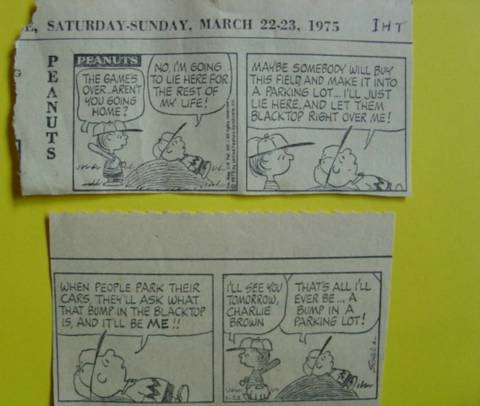
the only cartoon I ever saved

the only cartoon I ever saved

The art of reading Alain de Botton
Look at me with incredulity if you wish, but I have to admit, I am a big fan of the books of Alain de Bottom. I foisted his “How Proust can change your life” on many people (who now never ask me for book recommendations, feeling that I failed them profoundly the first time around). And I adored his “The Art of Travel” (thankfully that had a slightly larger following among my associates and book groups readers). AdeB is inordinately creative and clever, so that I forgive the little lapses here and there. No, actually I don’t even spot the lapses. And I refuse to be bothered by the labels that have quite unfortunately placed his books sometimes on shelves having the questionable “self-help” designation. (Borders knows to stick him in the Literature section where he belongs). You don’t read AdeB to improve anything – you read him because he is funny and perceptive and uses words masterfully to convey original, oftentimes quirky ideas.
So naturally I was happy beyond happy to see his newest book, Status Anxiety, on the Borders must-read table. I worried a tad about the title (I don’t think much about status anxiety in general and the topic struck me as dated), but I picked it up with enthusiasm nonetheless. AdeB can overcome even poor subject matter. He is THAT good.
I leafed through it and my one phrase summary is that it is better than it sounds, but not as good as it should be.
I did find one page slightly disconcerting. From what I could tell (I was “reading” the book standing by the table at Borders), AdeB was attempting to portray us as a consumerist society. Okay, so maybe he’s a little dry in the “original ideas” department. We all have slow phases. There was a day when I was forced to write a post about pink flamingos because nothing else came to mind.
But even more troubling were his examples of our rising expectations with respect to personal gratification. They misrepresent what, to me, is a more complicated reality.
Here, take a look at his little chart where he lists what we regard as necessities these days (30 years ago they were obscure goods and services, belonging, for the most part, only to the privileged):

a so-what table
Yes, okay, more of us can’t live without the AC. But think how much we have let go of, how lesser our expectations are with respect to other items! I can create a list too, flooding the reader with examples of what we have lost:
1970: 76% expected doctors to make housecalls when kids got sick
2000: You’re joking, right? 0%
1970: 82% of the faculty at a state universities expected to get salary increases that not only kept up with inflation but also paid for such things as family car trips to the Grand Canyon.
2000: 1% expect increases, the rest expect nothing and are happy if their departments aren’t eliminated during budget trimming exercises.
1970: 64% of school aged kids expected a twinkie every once in a while in their lunch sack.
2000: 2% of delusional dreamers still look for that twinkie. The rest have suffered a 50s-like indoctrination about the evils of these and other Hostess treats. We once feared communism, we now fear twinkies.
1970: 99.4% of travelers expected their intact suitcases to travel with them on airplanes.
2000: 17% expect to see their unscathed black upright on the conveyor belt after a flight (in Madison, that statistic goes down to 11%). For the rest – it’s time for a conversation with the voice-activated robot who will do nothing, absolutely nothing to assist in the search for missing and inevitably damaged luggage. [Those perverse Samsonite lifetime warranties! Does anyone keep the original sales receipt and then dutifully MAIL the damaged suitcase to the manufacturer for a refund?]
And so on.
But I forgive this table, I forgive all. AdeB is like the best of the best bloggers. You read him for the cleverness of the presentation, for the way he looks at the bland and spins it into the sublime (a word which figures prominently in his Art of Travel book). In fact, you could take his cited Nietzsche quote from the Art of Travel and throw it right back at him. Nietzsche writes “…we are in the end tempted to divide mankind into a minority (a minimality) of those who know how to make much of little, and a majority of those who know how to make little of much.” In my mind, AdeB is at the epicenter of that minimality.
So naturally I was happy beyond happy to see his newest book, Status Anxiety, on the Borders must-read table. I worried a tad about the title (I don’t think much about status anxiety in general and the topic struck me as dated), but I picked it up with enthusiasm nonetheless. AdeB can overcome even poor subject matter. He is THAT good.
I leafed through it and my one phrase summary is that it is better than it sounds, but not as good as it should be.
I did find one page slightly disconcerting. From what I could tell (I was “reading” the book standing by the table at Borders), AdeB was attempting to portray us as a consumerist society. Okay, so maybe he’s a little dry in the “original ideas” department. We all have slow phases. There was a day when I was forced to write a post about pink flamingos because nothing else came to mind.
But even more troubling were his examples of our rising expectations with respect to personal gratification. They misrepresent what, to me, is a more complicated reality.
Here, take a look at his little chart where he lists what we regard as necessities these days (30 years ago they were obscure goods and services, belonging, for the most part, only to the privileged):

a so-what table

Yes, okay, more of us can’t live without the AC. But think how much we have let go of, how lesser our expectations are with respect to other items! I can create a list too, flooding the reader with examples of what we have lost:
1970: 76% expected doctors to make housecalls when kids got sick
2000: You’re joking, right? 0%
1970: 82% of the faculty at a state universities expected to get salary increases that not only kept up with inflation but also paid for such things as family car trips to the Grand Canyon.
2000: 1% expect increases, the rest expect nothing and are happy if their departments aren’t eliminated during budget trimming exercises.
1970: 64% of school aged kids expected a twinkie every once in a while in their lunch sack.
2000: 2% of delusional dreamers still look for that twinkie. The rest have suffered a 50s-like indoctrination about the evils of these and other Hostess treats. We once feared communism, we now fear twinkies.
1970: 99.4% of travelers expected their intact suitcases to travel with them on airplanes.
2000: 17% expect to see their unscathed black upright on the conveyor belt after a flight (in Madison, that statistic goes down to 11%). For the rest – it’s time for a conversation with the voice-activated robot who will do nothing, absolutely nothing to assist in the search for missing and inevitably damaged luggage. [Those perverse Samsonite lifetime warranties! Does anyone keep the original sales receipt and then dutifully MAIL the damaged suitcase to the manufacturer for a refund?]
And so on.
But I forgive this table, I forgive all. AdeB is like the best of the best bloggers. You read him for the cleverness of the presentation, for the way he looks at the bland and spins it into the sublime (a word which figures prominently in his Art of Travel book). In fact, you could take his cited Nietzsche quote from the Art of Travel and throw it right back at him. Nietzsche writes “…we are in the end tempted to divide mankind into a minority (a minimality) of those who know how to make much of little, and a majority of those who know how to make little of much.” In my mind, AdeB is at the epicenter of that minimality.
Saturday, July 03, 2004
Where did you get those raspberries? Uh, sorry, I took the last ones…
Very early in the day, you could go to the Morren’s Fruit Farm stand today at the Market and buy these:

first raspberries of the season
My L’Etoile wagon was the foe of the people today as I moved around with it and wiped out many a supply: of the raspberries, of these carrots, too:

rainbow carrots
Though I passed on these exquisitely toned beets – not on the menu yet.

rainbow beets
It was a humid day and the Square was packed with out-of-towners (here for the holiday week-end). You can always tell – they dress differently and they buy things that don’t need refrigeration. And they always comment on the L’Etoile wagon. “Oh that’s from that French restaurant.” (French?) Or “What are you serving tonight?” (Me personally – nothing. In fact I’m not even cooking tonight, at the restaurant or at home, but I feel compelled to rattle off some menu items and give some general ideas on how shell peas or snap peas may appear on the dinner plate.)
I noticed that we are now fully into the July market. That means more yellow blooms:

pure gold

a yellow thistle?
Though I still favor the buckets of flowers, like for instance these:

nice!
During my rounds, I had a number of visits with Anne Topham, the Fantome Farm cheesemaker (see site here). Taking over a croissant from the bakery (she loves these treats), I stuck around for a while and listened to her talk about her newest experiments in cheesemaking. I am so in awe of a person who doesn’t rest on her successes but continues to play around with new ideas.
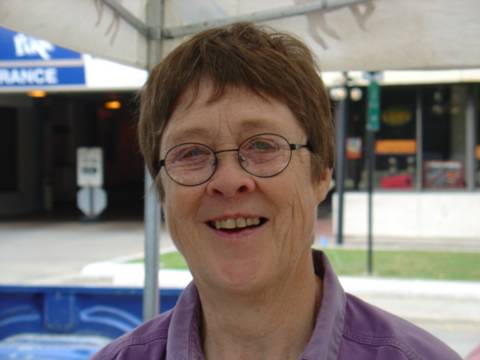
Anne of Fantome
She showed me the brand new labels they were using on the cheeses – each has a picture of one of the kid goats. Adorable!
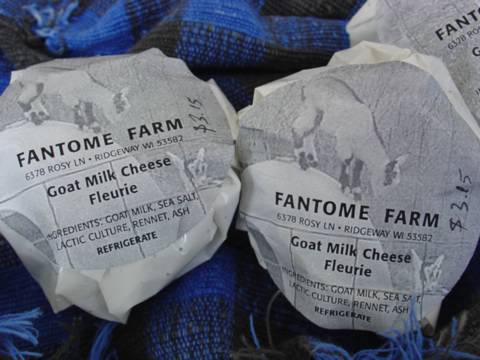
note the kids
If I may give a face to another big cheese person, here’s Felix, the goat feta guy who is now fiddling around with the goat milk ice cream. Felix talks with such gusto that you truly believe he is onto a spectacular new product that will revolutionize the food industry.
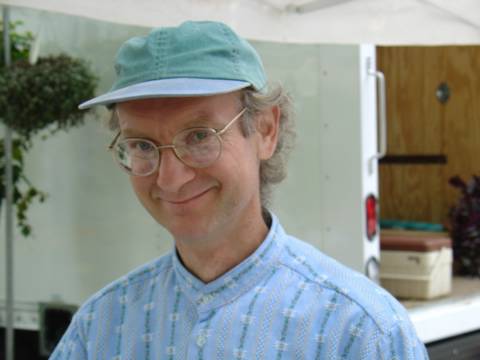
Felix of Capri Feta
In the middle of the morning, an anti-war demonstration passed through the Square. Not surprisingly, this guy caught my eye:

justice takes to the streets
In the end, I spent close to six hours at the Market. The last one was for myself. I picked up, among other things, several jeweled jars from this stand. One, of currant jelly, I will put to good use tomorrow. Check in then to see how indispensable a jar of jelly can be.

gems

first raspberries of the season

My L’Etoile wagon was the foe of the people today as I moved around with it and wiped out many a supply: of the raspberries, of these carrots, too:

rainbow carrots

Though I passed on these exquisitely toned beets – not on the menu yet.

rainbow beets

It was a humid day and the Square was packed with out-of-towners (here for the holiday week-end). You can always tell – they dress differently and they buy things that don’t need refrigeration. And they always comment on the L’Etoile wagon. “Oh that’s from that French restaurant.” (French?) Or “What are you serving tonight?” (Me personally – nothing. In fact I’m not even cooking tonight, at the restaurant or at home, but I feel compelled to rattle off some menu items and give some general ideas on how shell peas or snap peas may appear on the dinner plate.)
I noticed that we are now fully into the July market. That means more yellow blooms:

pure gold


a yellow thistle?

Though I still favor the buckets of flowers, like for instance these:

nice!

During my rounds, I had a number of visits with Anne Topham, the Fantome Farm cheesemaker (see site here). Taking over a croissant from the bakery (she loves these treats), I stuck around for a while and listened to her talk about her newest experiments in cheesemaking. I am so in awe of a person who doesn’t rest on her successes but continues to play around with new ideas.

Anne of Fantome

She showed me the brand new labels they were using on the cheeses – each has a picture of one of the kid goats. Adorable!

note the kids

If I may give a face to another big cheese person, here’s Felix, the goat feta guy who is now fiddling around with the goat milk ice cream. Felix talks with such gusto that you truly believe he is onto a spectacular new product that will revolutionize the food industry.

Felix of Capri Feta

In the middle of the morning, an anti-war demonstration passed through the Square. Not surprisingly, this guy caught my eye:

justice takes to the streets

In the end, I spent close to six hours at the Market. The last one was for myself. I picked up, among other things, several jeweled jars from this stand. One, of currant jelly, I will put to good use tomorrow. Check in then to see how indispensable a jar of jelly can be.

gems

Friday, July 02, 2004
A summary of a walk
It was, weather-wise, a near-perfect day. It took 50 minutes to walk from my home to Greenway (Madison’s newest shopping place, where I had a quick errand to do). It took another 1 hour and 40 minutes to walk from Greenway to Borders. During this extensive afternoon of walking (and head-clearing) I saw the following:
• 3 other pedestrians (yes, that’s right, in close to a three hour period of pedestrian biways, I encountered only three other walkers; they were in it for the exercise -- frankly, I was in it for the walk);
• 1 mailman;
• 1 woman jogging and pushing a baby stroller at the same time;
• more than 50 American flags gracing private residences (I have to admit, I am not much of a flag person unless we’re talking about the flags of all nations, strung out in front of the UN);
• a man stirring something ominous in a cauldron in his driveway. I asked what it might be. He told me he was making beer. Interesting.
I think we need build no more sidewalks in this town. No one uses them.
• 3 other pedestrians (yes, that’s right, in close to a three hour period of pedestrian biways, I encountered only three other walkers; they were in it for the exercise -- frankly, I was in it for the walk);
• 1 mailman;
• 1 woman jogging and pushing a baby stroller at the same time;
• more than 50 American flags gracing private residences (I have to admit, I am not much of a flag person unless we’re talking about the flags of all nations, strung out in front of the UN);
• a man stirring something ominous in a cauldron in his driveway. I asked what it might be. He told me he was making beer. Interesting.
I think we need build no more sidewalks in this town. No one uses them.
I should be in Poland right now...
...I have an invitation to deliver lectures at the Jagiellonian University in Krakow; I have a sister and father who would welcome me; and I long to take a walk through the Lazienki Park in Warsaw on a summer day. I must say, completely objectively now (yes, really, it is not my bias speaking here), that it is the most beautiful city park in the world.
Just two “photos of photos” I took in the park last time I was there during this season, 4 years ago (no digital camera then):

Chestnust shade
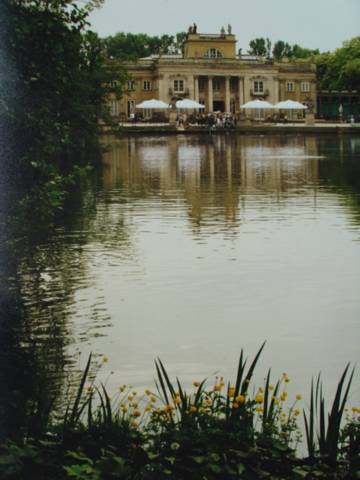
Lazienki Summer Palace and buttercups
However, yet again, I am stalling. I find it hard to fit in a Poland trip now. My family here, my extensive Asia travel that took a large chunk of time, my summer teaching, all these factors weigh against trips to Warsaw and Krakow during the spring and summer, thus for the last three years I have indeed been taking walks through Lazineki Park, but during times when it looked like this (in January):
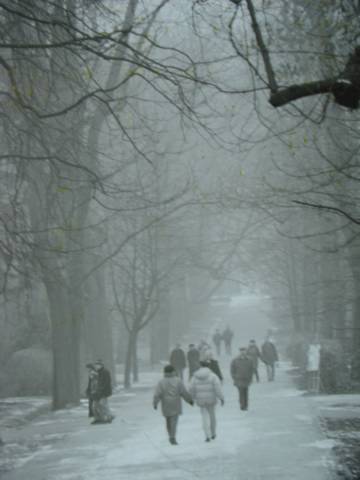
a winter stroll, Lazienki, 2001

Lazienki in the winter, 2001
One of the biggest regrets (in switching to winter travel) is that I have been missing out on visits to these old highlanders (their names are Anna and Stanislaw):
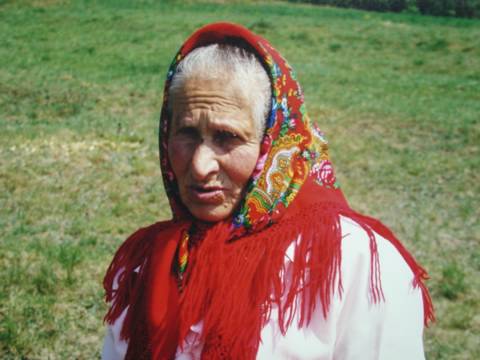
Anna, in her Sunday best
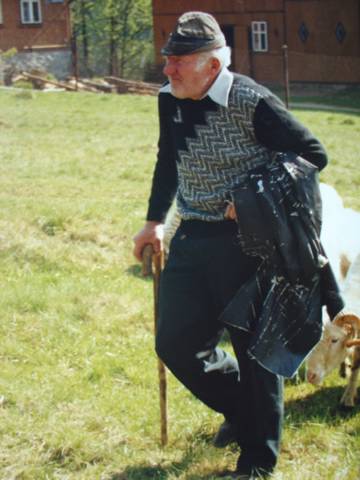
Stanislaw and his flock, 2000
…who live here:
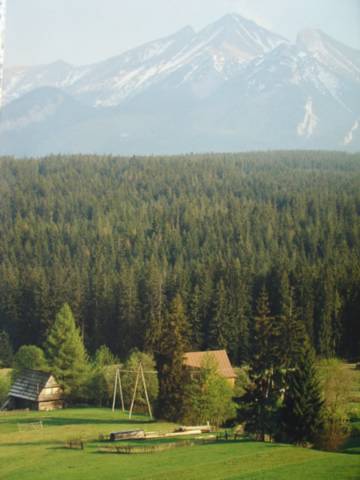
the valley of Rynias, Poland, 2000
I could go in the winter, but it’s a hard hike in the snow (their house is about a two hour walk from the nearest paved road) and I’ve grown more reluctant to use a wash basin and an outhouse (they have no indoor plumbing) in the dead of winter. Did I say hardy peasant stock? Maybe not so much…
I first met Anna and Stanislaw some 30 years ago during a trip to the Polish highlands. I have stayed in their place numerous times since, but I noticed that my last hike there was now four years ago. These days I just send them a card once a year (they always eagerly look for a few dollars in it – they have no steady source of income; they live off the land and tend to their sheep and they are getting very very old), but I have great regrets that I don’t visit more often. The cluster of houses (which includes theirs) in the middle of the Alpine valley is possibly the most peaceful spot I know of. You can think great thoughts and scheme ambitious plans in the early morning hours while sitting at the edge of the forest, watching the three families who live there go about their morning chores. The smells are as important as the view: the pines, the pasture, the smoke from the chimneys and the brilliantly crisp mountain air – it is always a heady moment when you take it all in and exhale. It defines peace.
I am telling myself that my next trip to Poland (at some yet to be determined time this year) will include a hike to see Anna and Stas no matter what the season. I’ll come away with a sack of dried mushrooms that she will have picked. More importantly, I’ll fill my head with all those ambitious plans and great thoughts. I need a dose of both.
Just two “photos of photos” I took in the park last time I was there during this season, 4 years ago (no digital camera then):

Chestnust shade


Lazienki Summer Palace and buttercups

However, yet again, I am stalling. I find it hard to fit in a Poland trip now. My family here, my extensive Asia travel that took a large chunk of time, my summer teaching, all these factors weigh against trips to Warsaw and Krakow during the spring and summer, thus for the last three years I have indeed been taking walks through Lazineki Park, but during times when it looked like this (in January):

a winter stroll, Lazienki, 2001


Lazienki in the winter, 2001

One of the biggest regrets (in switching to winter travel) is that I have been missing out on visits to these old highlanders (their names are Anna and Stanislaw):

Anna, in her Sunday best


Stanislaw and his flock, 2000

…who live here:

the valley of Rynias, Poland, 2000

I could go in the winter, but it’s a hard hike in the snow (their house is about a two hour walk from the nearest paved road) and I’ve grown more reluctant to use a wash basin and an outhouse (they have no indoor plumbing) in the dead of winter. Did I say hardy peasant stock? Maybe not so much…
I first met Anna and Stanislaw some 30 years ago during a trip to the Polish highlands. I have stayed in their place numerous times since, but I noticed that my last hike there was now four years ago. These days I just send them a card once a year (they always eagerly look for a few dollars in it – they have no steady source of income; they live off the land and tend to their sheep and they are getting very very old), but I have great regrets that I don’t visit more often. The cluster of houses (which includes theirs) in the middle of the Alpine valley is possibly the most peaceful spot I know of. You can think great thoughts and scheme ambitious plans in the early morning hours while sitting at the edge of the forest, watching the three families who live there go about their morning chores. The smells are as important as the view: the pines, the pasture, the smoke from the chimneys and the brilliantly crisp mountain air – it is always a heady moment when you take it all in and exhale. It defines peace.
I am telling myself that my next trip to Poland (at some yet to be determined time this year) will include a hike to see Anna and Stas no matter what the season. I’ll come away with a sack of dried mushrooms that she will have picked. More importantly, I’ll fill my head with all those ambitious plans and great thoughts. I need a dose of both.
Thursday, July 01, 2004
NO NO NO, I am not a Martha Stewart wannabe (especially these days), even if she and I share Polish roots
However, I do want to give just ONE more plug to a cake recipe. This is the easiest, the best the most unusual, the most impressive little piece of chocolate indulgence you’re ever likely to come across. I mentioned it before: it is a flourless chocolate extravaganza with a great deal of currant liqueur in it. The recipe calls for covering it with a chocolate glaze and preparing a crème anglaise to pour on the bottom of the plate. I do neither. I serve it naked, with just a few currants (available at the Harmony Valley market stand this month) sprinkled on top. But you don’t even have to include those.
When my friends in Poland asked a couple of years ago if I could bake them something I was especially fond of, I baked this. Anyone with a passion for chocolate will love it. Promise. The entire deal takes very little time and it is terrific.
Tonight’s finished product:
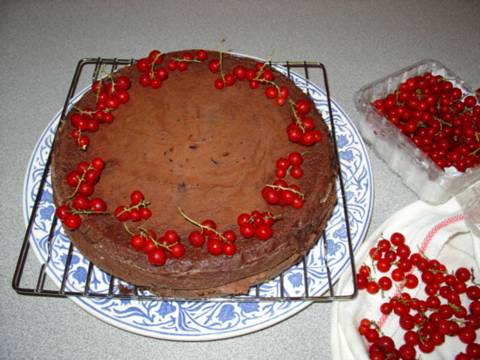
bittersweet chocolate and currants
Recipe (from Bon Appetit Magazine, 1994):
Flourless Chocolate-Cassis Cake
10 oz bittersweet or semisweet chocolate (Ghirardelli is great for this)
1 ½ sticks of unsalted butter
½ c unsweetened cocoa liqueur
5 large eggs
1 c sugar
Preheat oven to 350. Butter 9 inch springform pan (with high 2 inch sides), line bottom with parchment (wax will be okay too) paper, butter that as well, dust the whole inside of the pan with flour.
Melt butter with chocolate in medium pan on low heat, stirring until smooth.
Whisk in cocoa and cassis.
With electric mixer, beat eggs with sugar in large bowl until it almost triples in volume (about 6 minutes). Add chocolate-butter stuff and fold together.
THAT’S IT!!
Pour batter into pan, bake 40 minutes, take out, let stand for 5 minutes, run knife along sides then release springform, turn upside down onto rack and peel off paper. It may look gloppy and floopy – no matter! Kind of push together any crumbs that have fallen apart, or let them be, it’s all cool!
I love this cake warm, so I eat it right away. You probably should refrigerate (covered) whatever you don’t eat. But do take it out before the next eating session and bring it around for a couple of hours to room temperature. Oh, what the heck, it’s good in all ways. One guest likes to dribble heavy cream around the bottom. Another likes to take the currants off the stem and eat them together with the cake. It is so good, you will certainly find your way to enjoy it.
When my friends in Poland asked a couple of years ago if I could bake them something I was especially fond of, I baked this. Anyone with a passion for chocolate will love it. Promise. The entire deal takes very little time and it is terrific.
Tonight’s finished product:

bittersweet chocolate and currants

Recipe (from Bon Appetit Magazine, 1994):
Flourless Chocolate-Cassis Cake
10 oz bittersweet or semisweet chocolate (Ghirardelli is great for this)
1 ½ sticks of unsalted butter
½ c unsweetened cocoa liqueur
5 large eggs
1 c sugar
Preheat oven to 350. Butter 9 inch springform pan (with high 2 inch sides), line bottom with parchment (wax will be okay too) paper, butter that as well, dust the whole inside of the pan with flour.
Melt butter with chocolate in medium pan on low heat, stirring until smooth.
Whisk in cocoa and cassis.
With electric mixer, beat eggs with sugar in large bowl until it almost triples in volume (about 6 minutes). Add chocolate-butter stuff and fold together.
THAT’S IT!!
Pour batter into pan, bake 40 minutes, take out, let stand for 5 minutes, run knife along sides then release springform, turn upside down onto rack and peel off paper. It may look gloppy and floopy – no matter! Kind of push together any crumbs that have fallen apart, or let them be, it’s all cool!
I love this cake warm, so I eat it right away. You probably should refrigerate (covered) whatever you don’t eat. But do take it out before the next eating session and bring it around for a couple of hours to room temperature. Oh, what the heck, it’s good in all ways. One guest likes to dribble heavy cream around the bottom. Another likes to take the currants off the stem and eat them together with the cake. It is so good, you will certainly find your way to enjoy it.
To the reader who asked about my sister:
When time permits, my sister checks in here and reads these oddball posts. Why are they odd? Because her life in Warsaw could not be more different than mine here in Madison. I must appear nothing short of eccentric, writing about Ligurian cakes and blogger dinners. But she skims over this voluminous material nonetheless, because she is a kind person and because she cares, even though there is this great distance between us, a whole ocean and half a continent on each side.
She is a year older and a few inches shorter. From early in my childhood, I have regarded her as stunning to look at. She has the olive complexion, the chestnut hair, the delicate frame that catches your eye. I keep telling my mother that we must have gypsy blood running through because how else do you explain these very un-Slavic features? My mom used to agree, but for some time now she pretends she doesn’t know what I am talking about. I guess gypsy blood is no longer something that she wants to flaunt to the Public Out There.
When I felt inspired as a child to dance wildly around the house, I would make everyone tear-up with laughter (I didn’t intend to be funny, it was my best imitation of ballet). But Eliza* had grace. There were times when femininity was a desirable label for girls. Eliza oozed femininity. I ran (I still often run if I am in a hurry), she floated. I rode bikes through puddles and dug holes on the river beach; she sat back and watched with her beautiful big brown eyes. I filled pages and pages of numerous notebooks with rambling journal-like notes. She painted sunsets and birch groves and buttercups with delicate stems.
A reader asked me just yesterday if it’s hard living so far away. Most definitely. When I visit once a year, she gives me her room and always puts small bunches of flowers on the night table – great fistfuls of lilies of the valley in spring, pots of primroses in winter. We often drive to the village where my grandparents once lived (and we did as well, during our pre-preschool years) and where she is now trying to restore, with the help of her son, Chris, the house that my grandfather built. It’s slow going. But she is patient. I’m not. She is.
This photo of the river (with the terrific sandy bottom and waist-deep waters) that runs past my grandparents' house in the village of "Gniazdowo" was taken by me in 1973; obviously it was not a crowded landscape then or during my childhood. It still isn't.

River Liwiec, north-east Poland, 1973
Here’s a photo of the two of us (possibly the last one taken where she is still taller than me; soon after I shot up while she stayed petite). We are at the Baltic Sea. I am 5, she is 6. I am cold (according to me, it is always cold by the Baltic Sea), she is not. Gypsy blood, I tell you.

Eliza & Nina, 1958
*Her name is Eliza, and anyone who pronounces it E-lie-zah will have to withstand a glare from me, because this is NOT how she appears to me. She is E-lee-zah.
She is a year older and a few inches shorter. From early in my childhood, I have regarded her as stunning to look at. She has the olive complexion, the chestnut hair, the delicate frame that catches your eye. I keep telling my mother that we must have gypsy blood running through because how else do you explain these very un-Slavic features? My mom used to agree, but for some time now she pretends she doesn’t know what I am talking about. I guess gypsy blood is no longer something that she wants to flaunt to the Public Out There.
When I felt inspired as a child to dance wildly around the house, I would make everyone tear-up with laughter (I didn’t intend to be funny, it was my best imitation of ballet). But Eliza* had grace. There were times when femininity was a desirable label for girls. Eliza oozed femininity. I ran (I still often run if I am in a hurry), she floated. I rode bikes through puddles and dug holes on the river beach; she sat back and watched with her beautiful big brown eyes. I filled pages and pages of numerous notebooks with rambling journal-like notes. She painted sunsets and birch groves and buttercups with delicate stems.
A reader asked me just yesterday if it’s hard living so far away. Most definitely. When I visit once a year, she gives me her room and always puts small bunches of flowers on the night table – great fistfuls of lilies of the valley in spring, pots of primroses in winter. We often drive to the village where my grandparents once lived (and we did as well, during our pre-preschool years) and where she is now trying to restore, with the help of her son, Chris, the house that my grandfather built. It’s slow going. But she is patient. I’m not. She is.
This photo of the river (with the terrific sandy bottom and waist-deep waters) that runs past my grandparents' house in the village of "Gniazdowo" was taken by me in 1973; obviously it was not a crowded landscape then or during my childhood. It still isn't.

River Liwiec, north-east Poland, 1973

Here’s a photo of the two of us (possibly the last one taken where she is still taller than me; soon after I shot up while she stayed petite). We are at the Baltic Sea. I am 5, she is 6. I am cold (according to me, it is always cold by the Baltic Sea), she is not. Gypsy blood, I tell you.

Eliza & Nina, 1958

*Her name is Eliza, and anyone who pronounces it E-lie-zah will have to withstand a glare from me, because this is NOT how she appears to me. She is E-lee-zah.
Subscribe to:
Posts (Atom)

